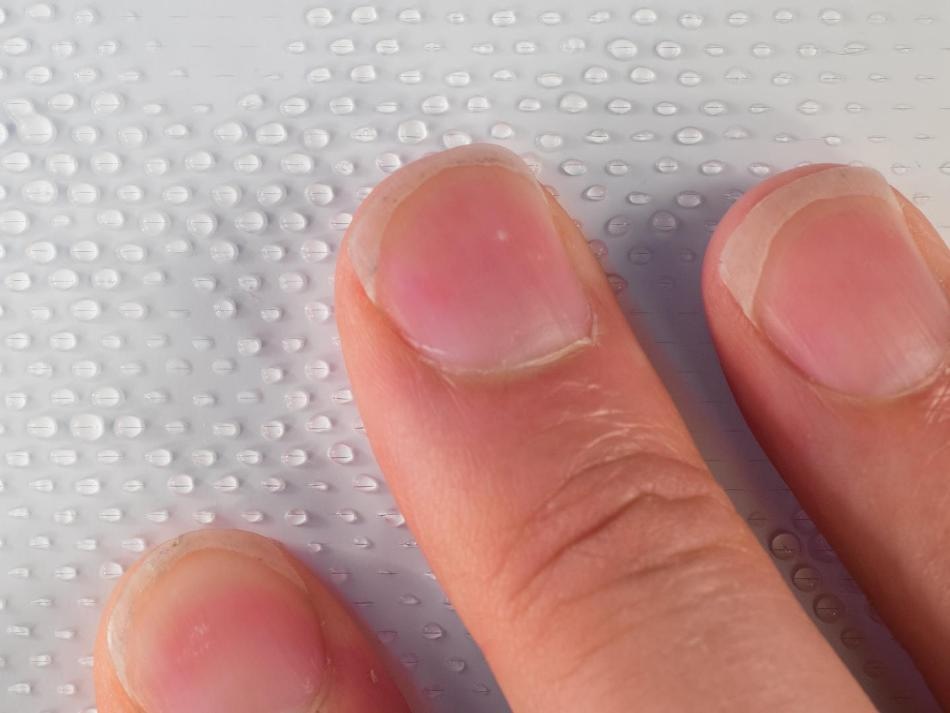Oct 6 2017
An innovative weapon has been developed by Scientists in the battle against deadly hospital-acquired infections - a textile capable of disinfecting itself.
 This is a close up of a Surfaceskins device showing the tiny valves that 'pump' alcohol gel onto the surface. CREDIT Surfaceskins
This is a close up of a Surfaceskins device showing the tiny valves that 'pump' alcohol gel onto the surface. CREDIT Surfaceskins
Independent tests demonstrate that it can reduce bacteria levels by more than 90%.
The Scientists aim to boost hand hygiene by integrating the specially-engineered textile in a device designed to be employed on hospital doors instead of the standard aluminum door plate, the part of the door that people push to open it.
The self-disinfecting device – called Surfaceskins - has been manufactured by a spin out company from the University of Leeds and is the result of seven years research and development.
Hospital doors are recognized as a key weak link in hygiene as the number of times people touch them.
It takes only one person with dirty hands to pass through a door to put everyone else who follows at risk of cross contamination.
Surfaceskins antibacterial door pads function by dispensing a tiny quantity of alcohol gel onto the pad when it is pushed, in order to disinfect the surface ready for the next person to use the door.
This cost-effective device, which combines three separate nonwoven textiles has been designed to be replaced after seven days or one thousand pushes, whichever comes sooner.
Surfaceskins antibacterial door pads are meant to provide an extra line of defense by helping clean hands to stay clean and are not meant to replace the strict handwashing rules in hospitals. Experts anticipate that Surfaceskins will bring about an increase in people's awareness of the significance of hand hygiene.
A study on the effectiveness of the new technology has been recently published in the Journal of Hospital Infection.
During the beginning of the study, both the Surfaceskins and control aluminum door plates were inoculated with bacteria at levels discovered on the hands of hospital staff. As a conclusion, the study highlighted that the Surfaceskins door pads were more effective than traditional door plates over seven days in decreasing the levels of three bacteria that commonly cause hospital-acquired infections: E. coli, E. faecalis and S. aureus.
Our results suggest that Surfaceskins door pads can help to reduce the contamination of doors by microbes. They offer a new way to reduce the risk of the spread of bacteria and viruses in hospital environments and other settings where frequent contact with doors could undermine hand hygiene.
Mark Wilcox, Professor of Medical Microbiology, The University of Leeds
Scale of hospital-acquired infections
Based on data published in 2014 by the National Institute for Care and Excellence or NICE, 300,000 patients in England get hospital-acquired infections on an annual basis.
The infections refer to increased treatment costs, estimated by NHS England to be around £1 billion annually, and put patients at risk of major harm.
Surfaceskins technology
The innovation behind Surfaceskins is protected by four patents. The device is attached into a plastic holster which is fixed to the door.
Surfaceskins comprise of a reservoir of alcohol gel and a membrane with small valves that dispense the gel onto the surface where it is pressed when opening a door, self-disinfecting it within just a few seconds.
Chris Fowler, Chief Executive of the spin out that has manufactued the device, said, "Surfaceskins address a definite need, in a simple, effective and low-cost way. Designed to provide protection in many high-risk situations, the global market for Surfaceskins is immense. In addition to the successful NHS trials, many organisations outside healthcare have expressed serious interest in introducing these self-disinfecting products. Surfaceskins can play an important role wherever door users have an interest in maintaining clean hands."
A door handle has been developed by the company by using the Surfaceskins technology.
Surfaceskins are currently targeted at other industrial sectors where there is a requirement for meticulous hand hygiene such as in hospitality and catering. They could also be employed on cruise ships where the spread of bacteria can result in eruptions of sickness.
On the back of agreed distribution deals and successful trials, Surfaceskins Ltd is presently looking for £600,000 investment in order to expand their production capability and sales network at their Leeds-based facility.
Nonwovens Innovation and Research Institute Ltd
Surfaceskins is a partnership between the Nonwovens Innovation and Research Institute Ltd (NIRI), a spin out company from the University's School of Design, and two Industrial Designers, Adam Walker and Simon Scott-Harden.
NIRI helps companies offer new textile ideas to market or to advance or improve existing manufacturing processes or products.
NIRI, since its establishment 12 years ago, has recently relocated into bigger premises in Leeds City Centre and has successfully completed 400+ projects for more than 200 clients.
Nonwovens is a group of textiles developed by interlocking or bonding individual filaments or fibers together, and includes a variety of products including wound dressings, filters, military clothing, imitation fur and nappies.